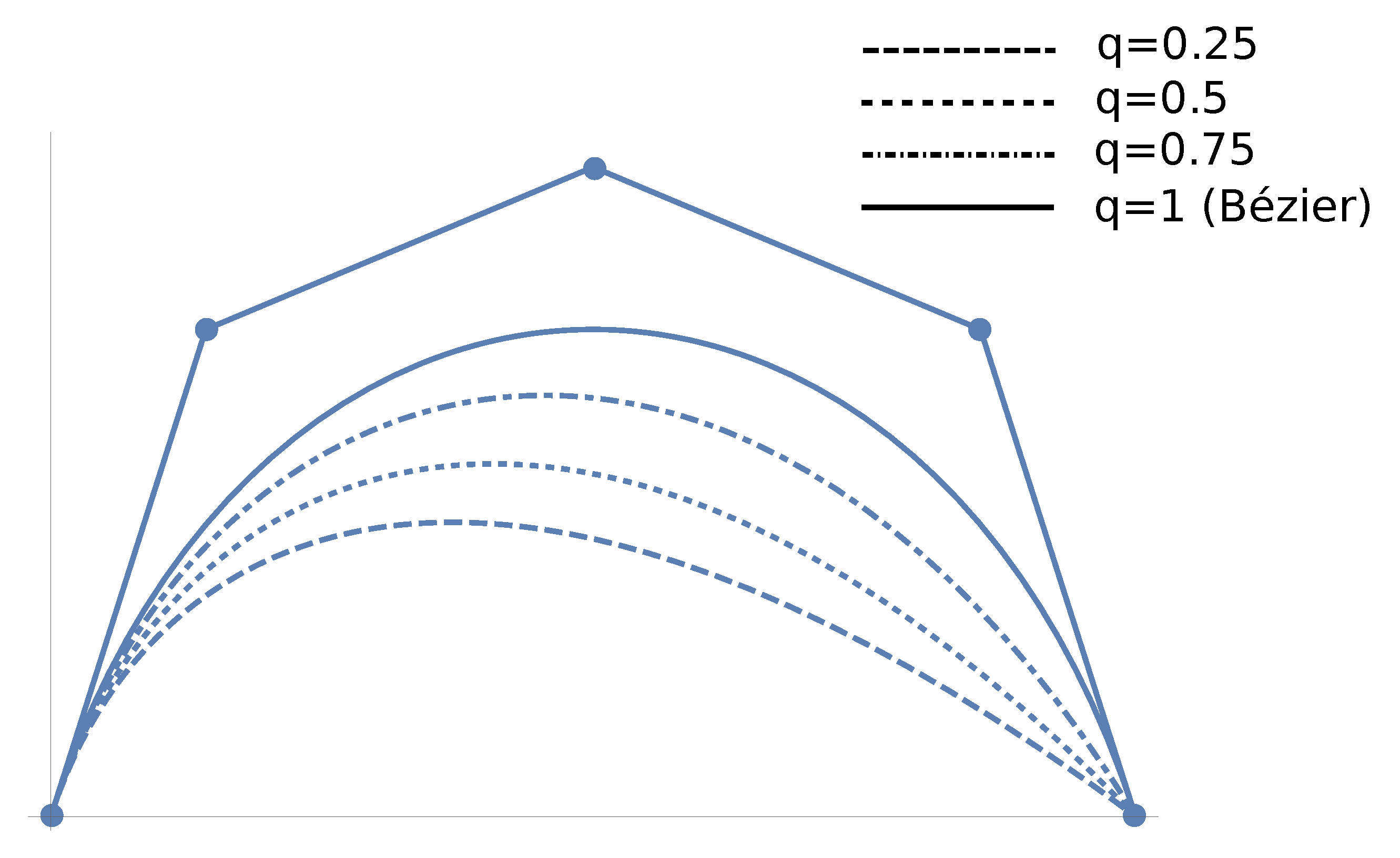Geometric Properties and Algorithms for Rational q-Bézier Curves and Surfaces
Abstract
:1. Introduction
2. q-Bézier Curves
2.1. Properties of q-Bézier Curves
- The q-Bernstein polynomials form a partition of unity:This property can be proved by induction by evaluating through Algorithm 2.
- The q-Bernstein polynomials are nonnegative: for all .
- Convex hull property: A q-Bézier curve is always contained inside the convex hull of its control points (see Section 2 of [8] for the case of rational q-Bézier curves; q-Bézier curves are a particular case of these curves).
- Affine invariance.
- Endpoint interpolation property: This is a consequence of the identities
- Invariance under barycentric combinations:
- Linear precision:See Proposition 5.2 of [9].
- The q-Bernstein polynomials of degree n, , form a normalized totally positive basis (see Section 2 of [10]).
- q-Bézier curves satisfy the variation diminishing property: the q-Bézier curve has no more intersections with any line than its control polygon (see Section 2 of [10]).
2.2. q-Casteljau Algorithms
| Algorithm 1 Evaluation of a q-Bézier curve |
|
| Algorithm 2 Evaluation of a q-Bézier curve |
|
2.3. Degree Elevation of q-Bézier Curves
3. Boundary Tangent Property for q-Bézier Curves
4. Rational q-Bézier Curves
4.1. Properties of Rational q-Bézier Curves
- The functions form a partition of unity:
- The functions are nonnegative: for all .
- Affine invariance.
- Endpoint interpolation property: This is a consequence of the identities
- Invariance under barycentric combinations:
- The rational functions form a normalized totally positive basis of the corresponding space of functions since any collocation matrix of this system of functions can be expressed as the product of three totally positive matrices and so it is totally positive. In fact, if we consider a collocation matrix of the system (5), it can be expressed as the product of the corresponding collocation matrix of the system premultiplied and post multiplied by diagonal matrices with positive diagonal entries.
- Rational q-Bézier curves satisfy the variation diminishing property: the rational q-Bézier curve has no more intersections with any line than its control polygon. This property is a consequence of the previous one.
4.2. q-Casteljau Algorithms for Rational q-Bézier Curves
| Algorithm 3 Evaluation of a rational q-Bézier curve |
|
| Algorithm 4 Evaluation of a rational q-Bézier curve |
|
4.3. Boundary Tangent Property for Rational q-Bézier Curves
4.4. Degree Elevation of Rational q-Bézier Curves
5. Rational q-Bézier Surfaces
| Algorithm 5 Evaluation of a rational q-Bézier surface |
|
| Algorithm 6 Evaluation of a rational q-Bézier surface |
|
6. Conclusions
Author Contributions
Funding
Conflicts of Interest
Abbreviations
| CAGD | Computer-Aided Geometric Design |
References
- Phillips, G.M. Bernstein polynomials based on the q-integers. Ann. Numer. Math. 1997, 4, 511–518. [Google Scholar]
- Goldman, R.; Simeonov, P. Two essential properties of (q,h)-Bernstein-Bézier curves. Appl. Numer. Math. 2015, 96, 82–93. [Google Scholar] [CrossRef]
- Goldman, R.; Simeonov, P.; Simsek, Y. Generating functions for the q-Bernstein bases. SIAM J. Discrete Math. 2014, 28, 1009–1025. [Google Scholar] [CrossRef]
- Carnicer, J.M.; Peña, J.M. Shape preserving representations and optimality of the Bernstein basis. Adv. Comput. Math. 1993, 1, 173–196. [Google Scholar] [CrossRef]
- Carnicer, J.M.; Peña, J.M. Totally positive bases for shape preserving curve design and optimality of B-splines. Comput. Aided Geom. Des. 1994, 11, 633–654. [Google Scholar] [CrossRef]
- Kac, V.; Cheung, P. Quantum Calculus, Universitext; Springer: New York, NY, USA, 2002. [Google Scholar]
- Delgado, J.; Peña, J.M. Accurate computations with collocation matrices of q-Bernstein polynomials. SIAM J. Matrix Anal. Appl. 2015, 36, 880–893. [Google Scholar] [CrossRef]
- Dişibüyük, Ç.; Oruç, H. A generalization of rational Bernstein-Bézier curves. BIT Numer. Math. 2007, 47, 313–323. [Google Scholar] [CrossRef]
- Simeonov, P.; Zafiris, V.; Goldman, R. q-Blossoming A new approach to algorithms and identities for q-Bernstein bases and q-Bézier curves. J. Approx. Theory 2012, 164, 77–104. [Google Scholar] [CrossRef] [Green Version]
- Oruç, H.; Phillips, G.M. q-Bernstein polynomials and Bézier curves. J. Comput. Appl. Math. 2003, 151, 1–12. [Google Scholar] [CrossRef] [Green Version]
- Phillips, G.M. A de Casteljau algorithm for generalized Bernstein polynomials. BIT 1996, 36, 232–236. [Google Scholar] [CrossRef]
- Dişibüyük, Ç.; Oruç, H. Tensor product q-Bernstein polynomials. BIT Numer. Math. 2008, 48, 689–700. [Google Scholar]



© 2020 by the authors. Licensee MDPI, Basel, Switzerland. This article is an open access article distributed under the terms and conditions of the Creative Commons Attribution (CC BY) license (http://creativecommons.org/licenses/by/4.0/).
Share and Cite
Delgado, J.; Peña, J.M. Geometric Properties and Algorithms for Rational q-Bézier Curves and Surfaces. Mathematics 2020, 8, 541. https://doi.org/10.3390/math8040541
Delgado J, Peña JM. Geometric Properties and Algorithms for Rational q-Bézier Curves and Surfaces. Mathematics. 2020; 8(4):541. https://doi.org/10.3390/math8040541
Chicago/Turabian StyleDelgado, Jorge, and J. M. Peña. 2020. "Geometric Properties and Algorithms for Rational q-Bézier Curves and Surfaces" Mathematics 8, no. 4: 541. https://doi.org/10.3390/math8040541
APA StyleDelgado, J., & Peña, J. M. (2020). Geometric Properties and Algorithms for Rational q-Bézier Curves and Surfaces. Mathematics, 8(4), 541. https://doi.org/10.3390/math8040541




